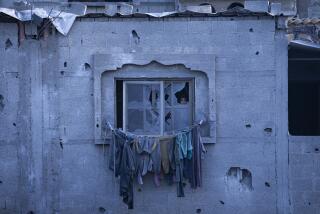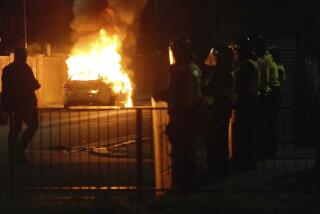Bombing Sites Searched for Bodies, Clues
- Share via
LONDON — Struggling against heat and rancid air, emergency crews Friday tried to reach bodies entombed in London’s famed Underground as the death toll in the terrorist bomb blasts a day earlier was certain to climb past 50.
Forensic specialists searched through the bloody, charred debris of three other bomb sites, as they tried to determine who carried out the coordinated attacks. Investigators said each of the bombs used in the blasts appeared to contain no more than 10 pounds of explosives and was small enough to be carried in a knapsack.
The deadliest attack on British soil since World War II paralyzed London’s vast transportation network, disrupted a summit of the leaders of the world’s richest countries being held in Scotland and expanded another front in global terrorism.
As this city fought to heal itself, desperate relatives embarked on searches for missing loved ones.
In smaller numbers than usual, Londoners went back to work Friday, boarding double-decker buses and Underground trains like those hit in Thursday’s bombings, which also wounded about 700 people. Scores remained hospitalized with burns, cuts and severed limbs. The official death toll stood at 49.
Police were on patrol outside many of London’s mosques during Friday prayers, bracing for a potential backlash against Muslims. The British government said it suspected that Islamist terrorists were behind the bombings of three trains and a bus, and the website assertions of a group claiming to have committed the acts on behalf of Al Qaeda were gaining currency.
Counter-terrorism officials promised to wage a manhunt of unprecedented proportion. Police were reviewing scores of surveillance tapes taken by subway cameras and interviewing hundreds of witnesses.
It “is blindingly obvious [that] there is likely to still be a cell” of terrorists active in Britain, Metropolitan Police Commissioner Ian Blair said.
“We must remain vigilant,” he said, calling on the public to cooperate in the investigation.
The driver of the bombed bus, in which 13 people were killed, said Friday that the vehicle had been diverted in the chaos that followed the subway blasts. That might have thrown off the timing for anyone who may have been transporting the bomb, causing the payload to explode before the intended destination, he speculated.
“There were many people trying to get on the bus at once,” driver George Psaradakis, 49, said on his company’s website. “Suddenly there was a bang, then carnage. Everything seemed to happen behind me.”
There has been intense speculation over whether the bus explosion, in contrast to the blasts on the subway cars, involved a suicide bomber, which would be the first such incident in Britain.
Investigators say a timing device may have been found in the bus debris, suggesting that the bombing was not intended to be a suicide mission.
Fearing the collapse of a tunnel on the stricken Piccadilly subway line, authorities said Friday that they still had not removed the tangle of bodies more than 100 feet below ground between the Russell Square and King’s Cross stations. They said they were confident there were no additional survivors.
The smashed carriage there is at least 500 yards within the tunnel, making access difficult. Work in the heated, cramped, rat-infested space can be sustained only for short periods. Emergency crews had to shore up the roof and walls of the tunnel to continue the search.
“They are very challenging scenes,” Assistant Police Commissioner Andy Hayman said, speaking at a news conference with Blair.
Once work inside the tunnel is completed, the death toll is expected to increase significantly, but not reach 100, Blair said.
Hayman said timing devices were discovered in the debris. The bombs appeared to have been placed on the floor of the subway cars, suggesting that they were planted and not attached to suicide bombers.
The evidence so far suggests that the blasts involved bombs smaller but similar to those used in attacks on the Madrid train system last year, in which 191 people were killed. Authorities traced the Madrid violence to a group of Islamic extremists mainly from Morocco. Most of the suspects were caught or killed within weeks of the bombings. But several allies of that terrorist cell remain at large, including at least one suspect who has had British residency documents.
A team of Spanish detectives was en route to London on Friday to help with the investigation.
More perplexing in the London carnage is the attack on the double-decker bus. After saying Thursday that only a few people were killed when the blast ripped off the bus’ upper level, authorities said Friday that they had recovered 13 bodies from the crumpled red vehicle.
Many of the bodies were badly mutilated, paramedics on the scene said, and blood and pieces of flesh were spewed on the facades of nearby buildings.
There has been widespread speculation that the bus attack was the work of a suicide bomber, or that a person transporting the bomb ended up killing himself inadvertently when the device blew up prematurely or because he was delayed by the detour of the bus.
The roof of the bus was ripped off nearly an hour after the first subway blast; all three Underground explosions were triggered within 26 minutes of one another.
Richard Jones, who said he got off the bus just before the blast, told British media that he had seen a man aboard in his mid-20s fidgeting with a bag.
European law enforcement officials briefed by British authorities said investigators may have recovered body parts belonging to a suspected bomber, which would be a significant clue in determining the identity of the culprits and tracing their networks.
“The British think they probably have the corpse of a terrorist among the dead on the bus,” a senior European official said. “They are pretty convinced that it is one of the suspects, and that the explosion may have been involuntary or ahead of schedule.”
Evidence has mounted in recent months that Europeans who went to Iraq to join the insurgency against U.S.- and British-led forces may be returning to the continent to continue their fight, forming a loose network that extends from North Africa to Britain.
The British government, like Spanish leaders shortly before the Madrid bombings, supports the war in Iraq, making Britain a target for some extremists.
“It’s an Al Qaeda-style attack almost to the point of being a cliche,” said Shane Brighton, head of intelligence for the Homeland Security and Resilience Department at the Royal United Service Institute for Defense and Security Studies. “It was multi-sited, coordinated in time, hit the transportation infrastructure and was meant to cause a high death count and cause maximum disruption.”
Several analysts said that those behind the London blasts would count the operation as a victory because they showed their ability to punch the gut of one of the world’s most security-conscious capitals and to expose the vulnerabilities of its vital transportation hub.
“This is a victory in that it caused fear and anxiety and stress,” said Mahan Abedin, editor of Terrorism Monitor, a journal published by the Jamestown Foundation, a Washington think tank. “They defeated the country’s policing and security systems.
“It shows they are powerful, that they can strike in Western capitals, and that they are strategically relevant.
“They have not been defeated, despite talk of how badly they have been weakened by the war on terrorism.”
Responding to allegations that the bombers exploited a security lapse, British Home Secretary Charles Clarke denied that authorities had received a specific warning just before the blasts.
“We are obviously looking very closely at all our intelligence to see if anything was missed,” Clarke said. “But, in fact, we don’t think anything was missed and it simply came out of the blue.”
A U.S. counter-terrorism official said the attacks may have been directed or conceived by Al Qaeda’s No. 2 leader, Ayman Zawahiri, an Egyptian believed to be hiding with top leader Osama bin Laden near the Afghan-Pakistani border.
When Zawahiri has made a public statement, a major attack has frequently occurred within three weeks, the U.S. official said. In a June 19 speech broadcast on Al Jazeera satellite television, he said that expelling U.S. forces and others from Muslim countries “will not be accomplished merely through demonstrations and hoarse throats in the streets. Reform and expelling the invaders from the lands of Islam will only be accomplished by fighting for the sake of Allah.”
For Londoners recovering from the blasts, the motives behind the violence took a back seat to grief Friday.
Despondent families made the rounds between hospitals and bomb sites in search of the missing.
The smiling faces of the missing were beginning to crop up on posters and in televised appeals: “Have you seen him?”
Some relatives expressed grief-tinged anger with authorities for failing to release adequate information, including complete lists of the names of the dead.
Meanwhile, Queen Elizabeth II, her son Prince Charles and his wife, Camilla, spent the day visiting the wounded, as well as those who had saved them.
“There was so much devastation around me,” Bruce Lait, a professional dancer injured in the Tube, told the queen as she stopped by his bedside at Royal London Hospital. “I can’t believe I made it.... I thought I was dead. And then I thought, no, I can’t be dead because I’m thinking.”
Elizabeth, wearing a lavender dress and white gloves, leaned over him to hear his story. Lait’s face was a palette of dried-blood speckles and dark jagged lines of stitching around his ear and along his neck.
“Those who perpetrate these brutal acts against innocent people should know that they will not change our way of life,” the queen said in a brief speech to the hospital staff. “I want to express my admiration for the people of our capital city who in the aftermath of yesterday’s bombings are calmly determined to resume their normal lives. That is the answer to this outrage.”
Indeed, many Londoners were adamant Friday about paying respects to the dead and regaining control of their lives. Residents placed bouquets on the steps of subway stations and deposited notes of condolence.
“London will go on,” one said.
“We can’t stop doing what we are doing at the moment,” Sheryar Tareen, 22, a clerk at Marks & Spencers department store said at the Baker Street Station as she joined a steady if subdued Friday morning commute. “It’s sad what happened, but I have to go to work.”
The Rev. Brian Lee, rector of the Episcopalian St. Botolph’s Church, near the shuttered King’s Cross Station, said Londoners, including the many parishioners he has been counseling since Thursday, would not surrender.
“That’s not the British spirit,” he said. “You get on. You won’t be defeated.”
*
Times staff writers Sarah Price Brown, John Daniszewski, Ken Silverstein, Janet Stobart and Carol J. Williams in London and Sebastian Rotella in New York contributed to this report.
More to Read
Sign up for Essential California
The most important California stories and recommendations in your inbox every morning.
You may occasionally receive promotional content from the Los Angeles Times.














